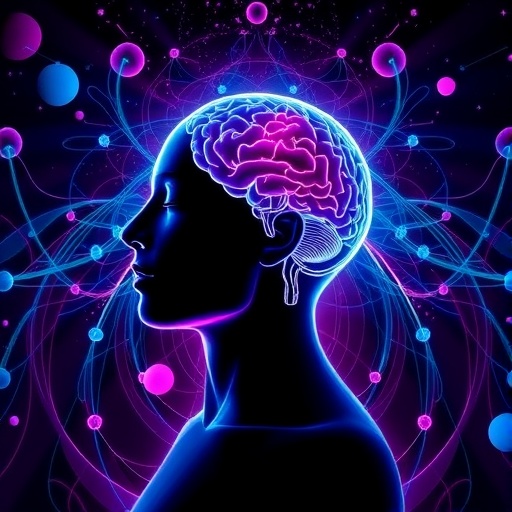A groundbreaking study from researchers at Brighton and Sussex Medical School has illuminated the intricate neurobiological underpinnings of altered states of consciousness (ASCs) induced by high ventilation breathwork (HVB) combined with music. Published on August 27, 2025, in the prestigious open-access journal PLOS One, this research pioneers the scientific exploration of breathwork’s effects on brain function, revealing profound psychedelic-like states that could revolutionize therapeutic practices for psychological distress.
Breathwork, an ancient practice gaining rapid popularity in mental health circles, involves controlled modifications of breathing patterns. When executed at high ventilation rates—with fast, deep breaths—in concert with music, practitioners report achieving states of bliss, insight, and emotional release. These subjective experiences bear remarkable resemblance to those elicited by psychedelic substances, such as psilocybin. However, until now, the neural correlates of breathwork-induced ASCs have remained poorly understood.
Led by Amy Amla Kartar and her colleagues in the Clinical Neuroscience Department, the study employed a multimodal experimental approach involving 15 online participants, 8 laboratory-based individuals, and 19 participants undergoing functional magnetic resonance imaging (fMRI). These participants engaged in a 20- to 30-minute continuous cyclic breathing protocol accompanied by curated music tracks designed to enhance the breathwork experience. Immediately following the session, they completed detailed questionnaires assessing their subjective states.
The neuroimaging revealed striking patterns of cerebral blood flow alterations accompanying the breathwork-induced ASCs. Although HVB generally led to widespread cerebral hypoperfusion—an overall decrease in blood flow—the researchers identified key exceptions. Notably, increases were observed in the right amygdala and anterior hippocampus, regions deeply implicated in emotional memory processing and affective regulation. This localized hyperperfusion correlated with participants’ reports of profound emotional catharsis and psychedelic-type experiences.
Simultaneously, blood flow to the left operculum and posterior insula diminished significantly. These brain areas are central hubs in interoception, the brain’s awareness of internal bodily states such as respiration. The suppression of activity here may facilitate a decoupling from the usual bodily self-awareness, a hallmark of altered consciousness. This neurovascular pattern hints at a complex, region-specific modulation of brain networks during breathwork, whereby internal bodily signals are attenuated while emotional and mnemonic circuits become hyperactive.
Physiological data corroborated these findings. Heart rate variability, a proxy for autonomic nervous system activity, decreased in tandem with increasing ASC intensity, suggesting sympathetic nervous system activation—often associated with stress responses. Intriguingly, this sympathetic activation did not translate into negative subjective outcomes. On the contrary, participants consistently reported reductions in fear and negative emotions, underscoring a potential paradox where physiological stress might coexist with, or even facilitate, therapeutic emotional breakthroughs.
One of the most captivating aspects of the study was the reliable induction of Oceanic Boundlessness (OBN) through HVB. First coined by Sigmund Freud in 1920 and popularized in psychedelic research, OBN encompasses experiences of spiritual unity, bliss, deep insight, and self-transcendence. The researchers found that breathwork elicited these states across diverse settings and participant groups without adverse effects, suggesting a safe and accessible path to profound altered consciousness.
The authors emphasize the novelty of their approach as the first to integrate neuroimaging with breathwork protocols, thereby bridging a critical gap in the understanding of non-pharmacological methods to induce ASC. They propose that changes in specific brain regions related to self-awareness, fear modulation, and emotional memory are key mechanistic substrates underlying the observed phenomenology of breath-induced psychedelic states.
Future work, the authors caution, should include larger sample sizes and rigorous control conditions to disentangle the independent contributions of music and breathing patterns. Nevertheless, these preliminary findings illuminate the transdiagnostic therapeutic potential of HVB, particularly as a legally and ethically unrestricted alternative to psychedelic-assisted therapies, which often face logistical and regulatory hurdles.
Lead author Amy Kartar reflects on the journey, highlighting the excitement of scientifically validating a practice embraced anecdotally by many. Her team’s findings represent an important step towards harnessing breathwork’s neuromodulatory effects for clinical interventions, especially in mental health conditions characterized by emotional dysregulation and trauma.
Principal investigator Dr. Alessandro Colasanti underscores the clinical implications, describing breathwork as a powerful, natural tool for neuromodulation. By orchestrating systemic metabolic shifts and modulating neurovascular function, HVB holds immense promise as an accessible, effective, and non-invasive therapeutic approach. As the field moves forward, breathwork could become a cornerstone modality within integrative psychiatry.
Together, these findings catalyze a paradigm shift in understanding consciousness alteration absent pharmacology. The neurovascular signatures and subjective phenomena elucidated here illuminate how simple, rhythmically modulated breathing intertwined with music powerfully recalibrates brain dynamics, evoking states historically confined to psychedelics. This nexus of respiratory physiology, emotion, and consciousness illuminates new frontiers in mind-body science and therapeutic innovation.
The intersection between breath and brain unearthed by Kartar and colleagues opens exciting avenues for translational research and clinical application. Beyond mental health, HVB’s potential to enhance wellbeing, cognitive flexibility, and emotional resilience positions it as a versatile tool for a wider population. As science peels back layers of the mind’s mysteries, breathwork emerges as an elegant key—rooted in biology, amplified by culture, and ripe for exploration.
Subject of Research: People
Article Title: Neurobiological substrates of altered states of consciousness induced by high ventilation breathwork accompanied by music
News Publication Date: 27-Aug-2025
Web References: http://dx.doi.org/10.1371/journal.pone.0329411
References: Kartar AA, Horinouchi T, Örzsik B, Anderson B, Hall L, Bailey D, et al. (2025) Neurobiological substrates of altered states of consciousness induced by high ventilation breathwork accompanied by music. PLoS One 20(8): e0329411.
Image Credits: Air Hunger, directed by Bob van de Gronde, CC-BY 4.0
Keywords: high ventilation breathwork, altered states of consciousness, psychedelic-like experience, neuroimaging, cerebral blood flow, emotional memory, oceanic boundlessness, autonomic nervous system, respiratory modulation, non-pharmacological therapy




